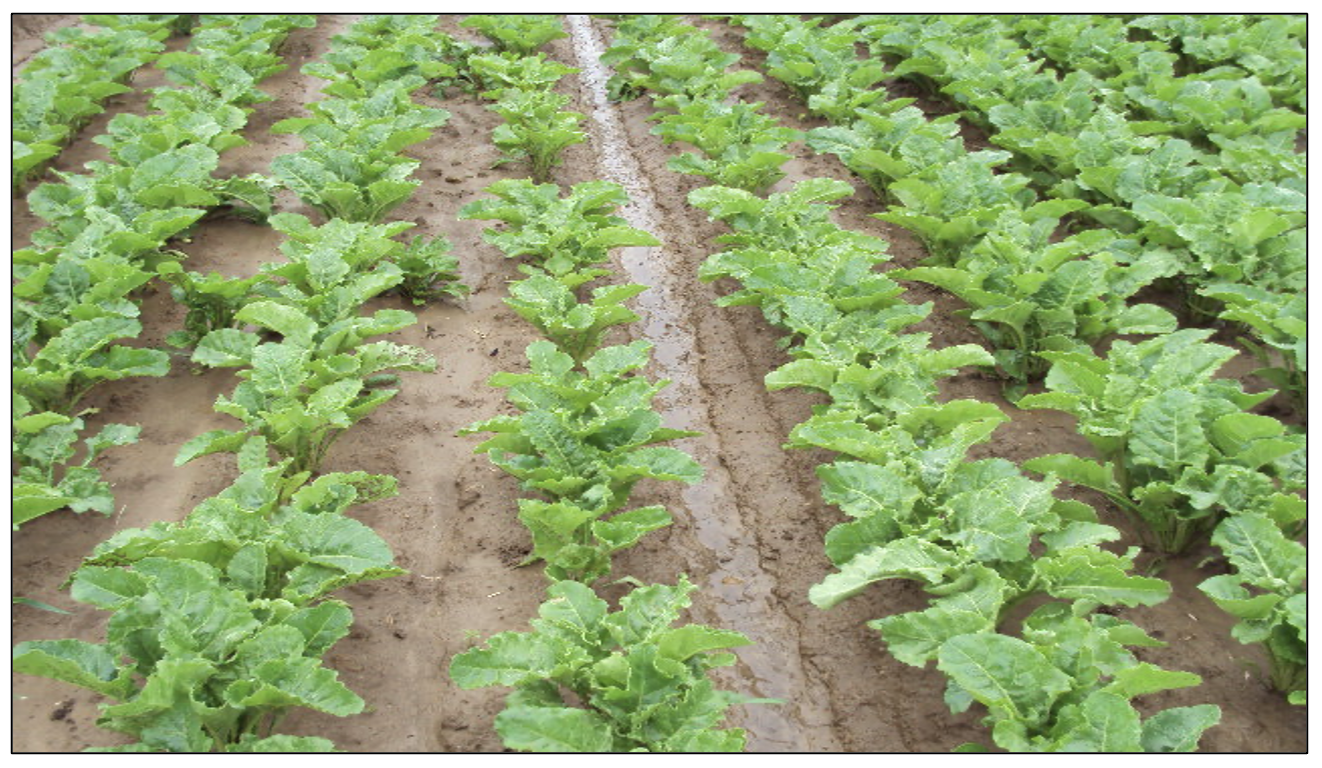Effect of bio-fertilizer application AZOTER® for nutrient content in the soil, plant nutrient status, crop yields and production quality.
![]()
Sumary of the result evaluation of 2018
* * *
Ing. Tomáš Javor, DiS.; Ing. Jitka Grygarová; Ing. Lenka Beranová, DiS.
AGROEKO Žamberk spol. s r.o., služby pro zemědělství a ekologii, Zemědělská 1004, 564 01 Žamberk
Petr Junek
Podorlické zemědělské družstvo Ohnišov, 517 84 Ohnišov 11
OILSEED RAPE: Effect of the fertilizer on the vegetation and nutritional health of oilseed rape in the territory of Hořičky (o. NA) – control measurement
Grower: Jan Pacák, Hořičky
Soil characteristics: soil type Luvisol modal, Albi-Haplic luvisol from colluvial loams 400 m above the sea level, soil pH value = 5,1-6,7, available nutrient : P = 50-53 mg/kg, K = 106-193 mg/kg, Ca = 1440-2380 mg/kg, Mg = 201-244 mg/kg, hybrid variety – semi dwarf hybrid variety PR45D03.
Application of the bacterial preparation with the effect of the AZOTER L fertilizer in oilseed rape was performed on 20. 4. at the beginning of butonization (BBCH 51). 10 days after the application, in the period of flowering, plant and soil samples were taken on 30. 4. The samples were taken in order to determine the vegetation and nutritional state . Control measurement was performed on the untreated soil (control) and on the neighbouring plot, treated with AZOTER L fertilizer.
After the application, the growth of oilseed rape showed a different dry matter weight of the aboveground biomass. In the beginning of flowering, 10 days after the application of AZOTER L fertilizer, a 36 % increase in the weight of aboveground biomass was found, compared to the untreated control (Table 1). The plant stand absorbed nitrogen from the soil more efficiently to stimulate the growth of the aboveground biomass. The soil under the treated plant stand with AZOTER L fertilizer on the leaf showed sufficiently lower content of the mineral nitrogent (TSLm) in the soil compared to the less grown and untreated plant stand. Residual supply of 51 kg N/ha in the soil in the beginning of flowering was sufficient enough to finish the nitrogen nutrition of the plants order to get a high yield.
Table 1. Comparison of mineral nitrogen content (Nmin) in the soil and the dry matter weight of the aboveground biomass of oilseed rape in the period of the early flowering (BBCH 61), on 10th day after the application of AZOTER L fertilizer.
| Treatment | Dry matter (%) | N-NO3 (mg/kg) | N-NH4 (mg/kg) | Nmin. (mg/kg) | Supply Nmin. (kg/ha) | Dry matter of aboveground biomass (t/ha) |
| Control | 86,50 | 22,00 | 18,40 | 40,45 | 162 | 3,56 |
| Azoter L | 85,85 | 8,34 | 4,29 | 12,63 | 51 | 4,84 |
| 100 % = K | – | 38 | 23 | 31 | – | 136 |
On the 10th day after the application of the AZOTER L fertilizer, a 51 kg / ha higher intake of nitrogen (N) was found on the aboveground biomass of rape (Graph 1). After application of AZOTER L fertilizer at the beginning of flowering, the plants received 125 kg N/ha on the untreated control plot and 176 kg N/ha on the neighbouring plot. The treatment had a synergistic effect on the intake of other macronutrients. After the treatment, plants received phosphorus 20 kg / ha (control 16 kg P / ha), potassium 173 kg / ha (control 128 kg K / ha), calcium 56 kg / ha (control 52 kg Ca / ha), magnesium 10 kg / ha (control 9 kg Mg / ha) and sulfur 21 kg / ha (control 16 kg S / ha).
On the untreated and treated variant of the plant stand in the early flowering, rape plants showed nutritional value of nitrogen in the narrow range of 88-91% optimum, phosphorus at the level of 89-96% optimum, potassium at the level of 119-120% optimum, calcium at the level of 73-97% optimum, magnesium at the level of 105-120 % and sulfur at the level of 71% optimum. The application of AZOTER L fertilizer supported the rate (stimulation) of the growth of dry matter of aboveground biomass during vegetation while maintaining comparable contents of the macro-elements in the dry matter of plants in the control without application.
Graph 1. Comparison of the biological intake of nutrients in rape plants in the period of early flowering (BBCH 61) with the untreated control and AZOTER L treated variant, on 10th day after application.
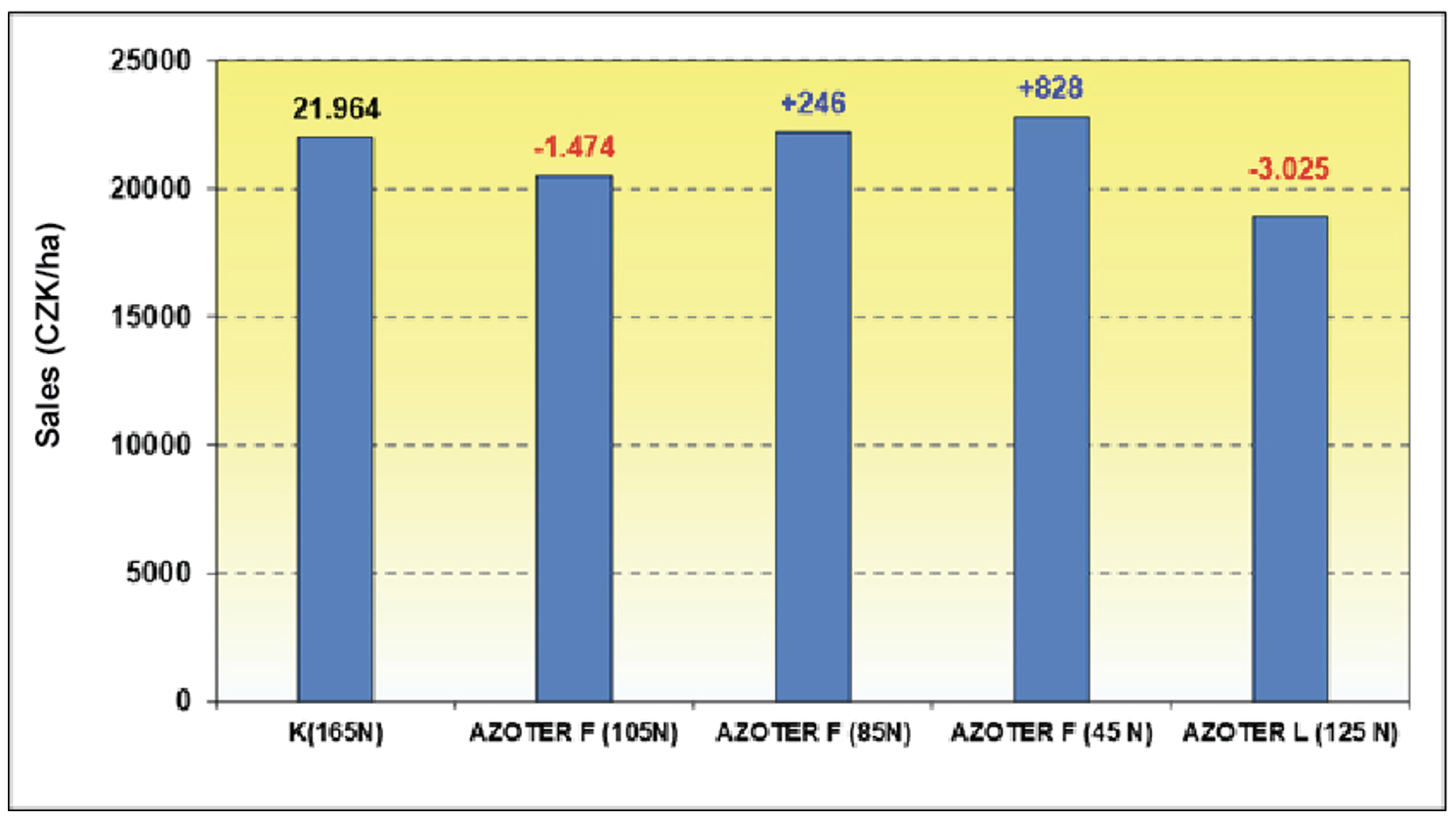
In an extremely dry year, rape plants provided a comparable yield in the range of 3.4 – 3.6 t / ha on those variants that were treated with AZOTER L fertilizer and the untreated control plot. After the harvest of the previous grain crop, AZOTER F was applied on the treated plot and on the untreated control plot to support the decomposition of straw by reducing the wide ratio of carbon and nitrogen and the synergistic development of soil bacteria and fungi. Another more accurate comparison of yield and seed quality after the application of AZOTER L fertilizer and its performance on untreated control plot is being prepared for 2019.

MAIZE FOR SILAGE: Effect of the AZOTER L fertilizer on the vegetation and nutritional health, yield and quality in the territory of Slatina nad Zdobnicí (o.RK) – control measurement
Grower: ZDOBNICE a.s. Slatina nad Zdobnicí
Soil characteristics: soil type Cambisol modal, dystric on marls and siltstones, 533 m above the sea level, soil pH value = 5,9, available nutrients: P = 101 mg/kg, K = 130 mg/kg, Ca = 1720 mg/kg, Mg = 247 mg/kg, S = 9,5 mg/kg, variety LG 30.238.
Application of the AZOTER L bacterial fertilizer in the maize silage stand was carried out on 11th June, at the 5thleaf stage. After 14 days from the application, a sample of the plants was taken on 25th June at the 7th leaf stage to determine the vegetation and nutritional state. Control measurement was performed on a representative plot with untreated and treated variant of AZOTER L fertilizer.
The untreated control showed a dry matter weight of aboveground biomass of 2.93 t/ha. A 40% increase in the dry matter weight of aboveground biomass, ie to 4.09 t / ha was found on the variant treated with AZOTER L fertilizer. After application of AZOTER L fertilizer, the plants showed a nitrogen intake of 101 kg/ha. Nitrogen intake of only 62 kg/hawas on the untreated control plot (Graph 2). The intake was increased by a higher growth in the dry matter weight of the plants and the content of ingested (utilized) nitrogen in the plants. Synergically, the application caused higher intake of phosphorus to 11 kg/ha (control 7 kg/ha), potassium to 117 kg/ha (control 90 kg/ha), calcium to 22 kg/ha (control 13 kg/ha) and magnesium to 11 kg/ha (control 7 kg/ha).
Graph 2. Comparison of the biological intake of nutrients in maize plants at the 7th leaf stage (BBCH17) with the untreated control and treated variant AZOTER L, on 14th day after application.
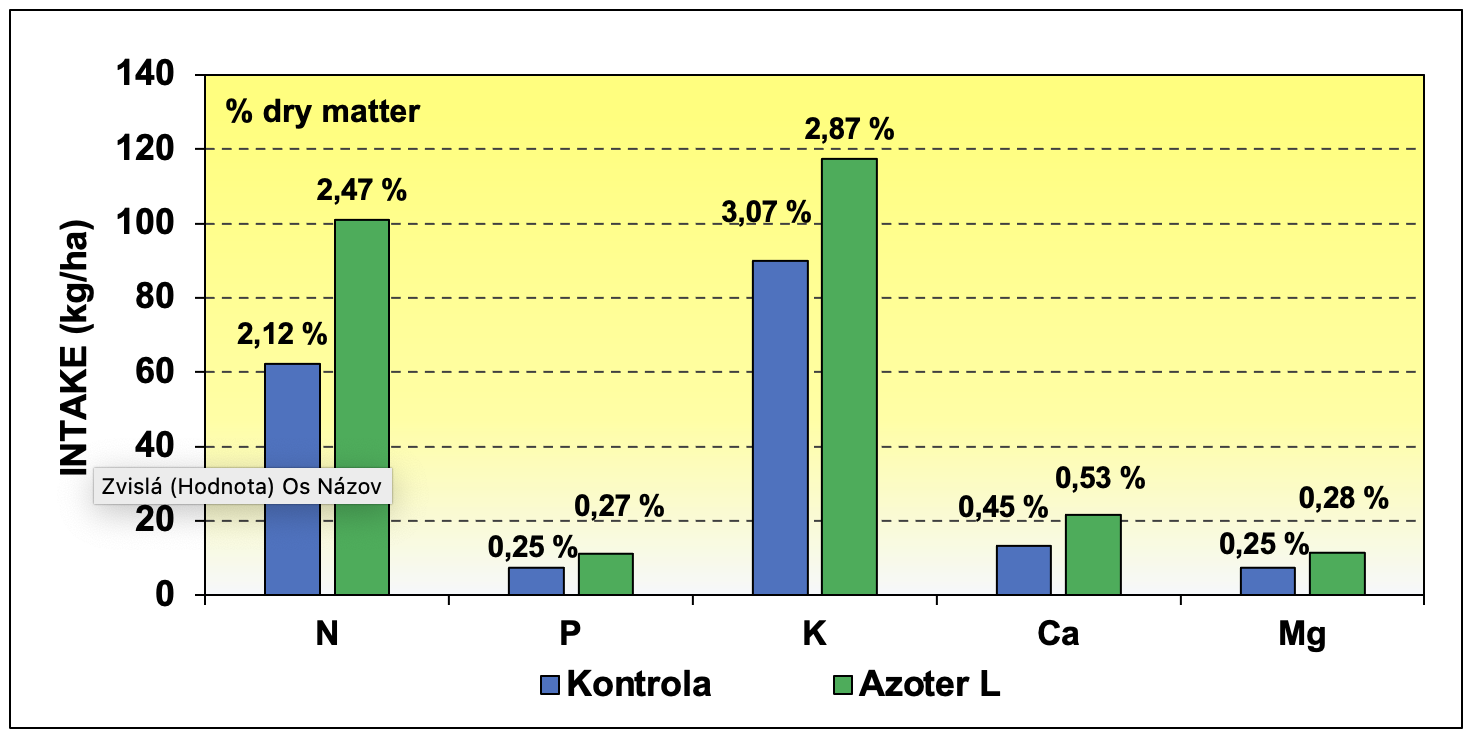
Significant support of the growth and nitrogen intake, including synergistic effect in receiving of other macronutrients, was positively reflected in the forage harvest on 22nd August. The yield of fresh forage was performed separately by sampling the whole plants while maintaining the normal height of the stubble. Plant cover that was not treated with AZOTER L fertilizer showed a dry forage yield of 11.1 t/ha (Table 2). The plant stand treated with AZOTER L showed a 44% higher yield. The difference in yield was statistically significant at the level of 95%. The dry matter in the forage at the harvest time was comparable- on the untreated control plot it was 36.2% and on the treated variant it was 37.3%.
After the application of AZOTER L, increasement in forage yield was due to a 21% higher number of grains in the row in the cob, a 26% higher weight (size) of thousands of grains. The application also increased the weight of the cobs in the forage by 2.6%. Application in an extremely dry year prolonged the assimilation and conversion of sugar to starch.At the same time, the application increased the content of nitrogenous substances (NL) while maintaining the optimal content for conservation.
Table. 2. Comparison of the yield and quality structure of maize forage at harvest on the untreated control and on the variant treated with AZOTER L in the period at 5 leaf stage.
| Treatment | Yield (t/ha) | No. of rows (pcs./cob) | No. of grains (pcs./rowcob) | HTZ (g) | Weight of cobs ratio (%) | Dry matter (%) | |||
| Fresch weight | Dry matter | starch | LR sugar | NL | |||||
| Control (K) | 30,8a±2,7 | 11,1a±1,0 | 13a±1,1 | 24a±3,8 | 312 | 38,1a±5,4 | 21,9 | 9,1 | 7,7 |
| Azoter L (A) | 44,2b±7,6 | 16,0b±2,8 | 12a±1,6 | 29a±2,8 | 392 | 40,7a±8,0 | 27,0 | 7,9 | 8,3 |
| 100 % = K | 143 % | 144 % | 92 % | 121 % | 126 % | 2,6 | 5,1 | -1,2 | 0,6 |
Note: Values marked in the column with different letters (a, b) show a statistically evidential difference at the significance level of p <0.05 (ANOVA, Fisher’s LSD test).
Plant one week before AZOTER L application Average cob and graining at harvest after
(in developed 5th leaf, beginning of dry weather) AZOTER L application -plant in 5th leaf stage
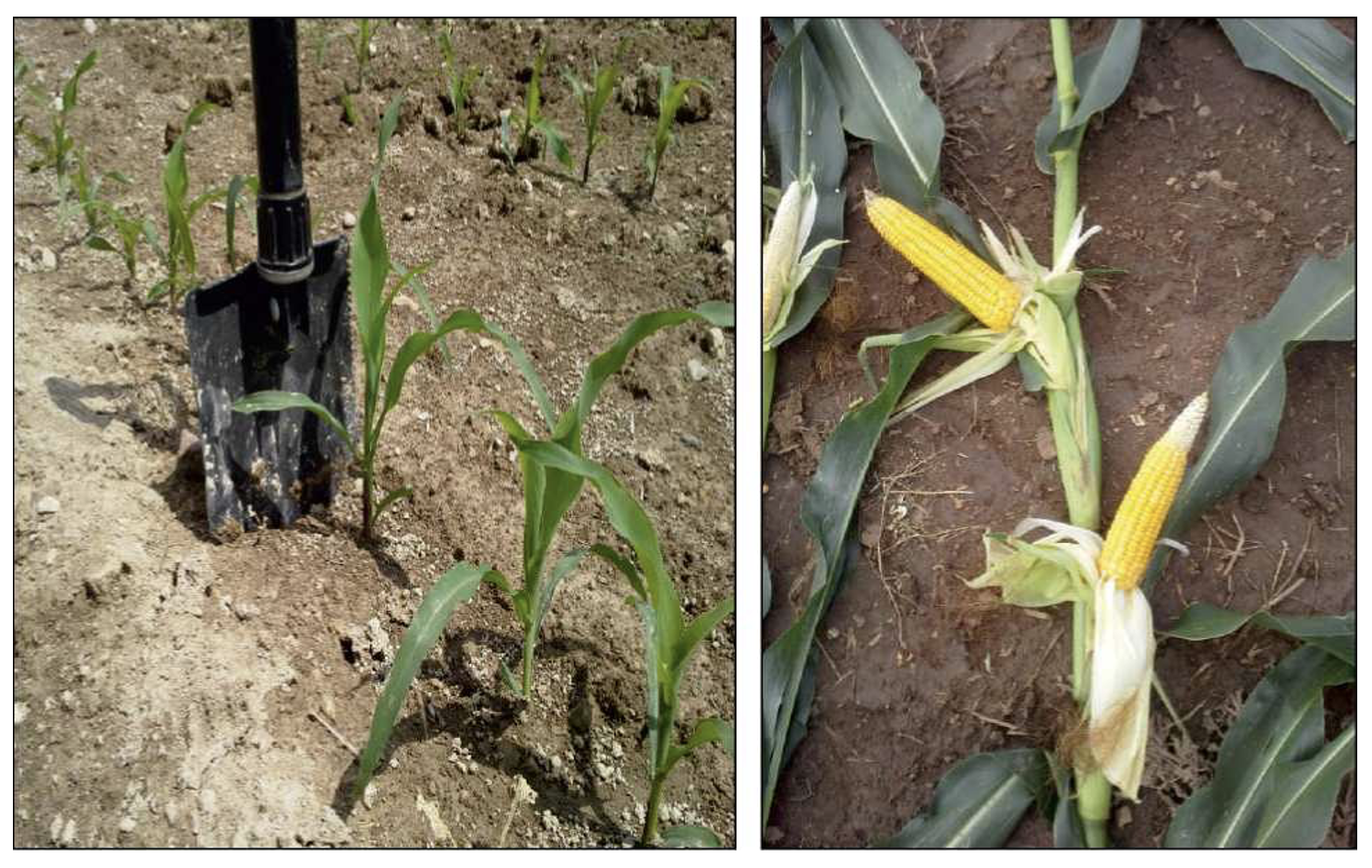
SUGAR BEET: Effect of the AZOTER L fertilizer on the vegetation and nutritional state of sugar beet in the territory of Lhota pod Hořičkami (o. NA) – control measurement
Grower: Zemědělské družstvo Dolany (agricultural cooperative), Lhota pod Hoŕičkami
Soil characteristics: soil type Luvisol modal, Albi- Haplic livisol from colluvial loams 350 m above the sea level, soil pH value =7,1, available nutrient: P =140 mg/kg, K = 223 mg/kg, Ca = 4080 mg/kg, Mg = 155 mg/kg, variety Gorila
The application of AZOTER L bacterial fertilizer in the sugar beet plant was carried out on 20th June during the period when the space between the rows of the leaves of neighboring plants (BBCH 33) closes. On July 2nd, after 12 days from the application date, a sample of plants in a fully involved stand (BBCH 42) was taken, to determine the vegetation and nutritional state. The control measurement was performed on a representative plot with an untreated and treated AZOTER L variant of fertilizer.
The untreated control showed a nitrogen intake of 102 kg / ha in the period of full plant stand (Graph 3). Nitrogen uptake of 186 kg / ha was found on the treated variant with AZOTER L fertilizer. Phosphorus uptake was 9 kg. There was a synergistically increase to 11 kg / ha on the variant treated with AZOTER L. Potassium intake on the untreated control variant was 237 kg / ha. After AZOTER L application the plant showed a higher potassium intake, 308 kg / ha.
On the untreated variant, the calcium intake was 42 kg / ha and the magnesium intake was 19 kg / ha. Applied treatment of the stand with AZOTER L fertilizer had a positive effect on higher intake of calcium 76 kg / ha and magnesium 34 kg / ha. Except of phosphorus and potassium, the application of AZOTER L fertilizer caused an increase in the nutrient content in the dry matter of the plants parallel to the stimulation of a faster growth of the weight of the aboveground biomass. At the time of the evaluation, the content of phosphorus and potassium in the dry matter of plants was diluted by a faster increase in the dry weight of aboveground biomass. In the later period, the content of phosphorus and potassium could increase due to a higher storage capacity of the plant assimilation apparatus after the application of the AZOTER L fertilizer.
Graph 3. Comparison of the biological intake of nutrients in sugar beet plants in the period of full plant stand (BBCH 42) on untreated control and in the variant treated with AZOTER L, on 12th day after its application.
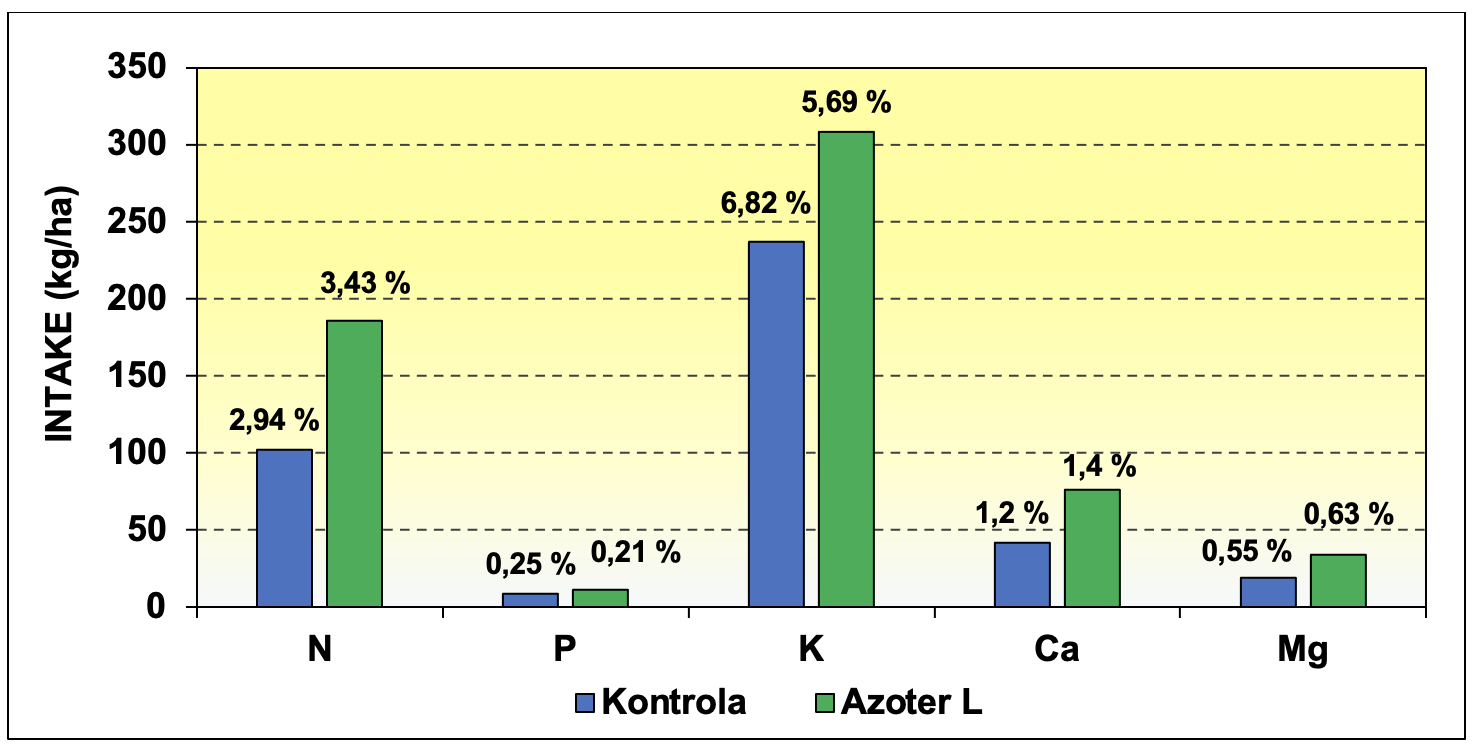
The nutritional status of the sugar beet plant was classified to fulfill 107% of the optimum of nitrogen content during the period of plant stand inclusion (BBCH 42). The stand treated with AZOTER L fertilizer showed a nutritional status of nitrogen at the level of 125% optimum. In the untreated control, phosphorus nutrition was higher, at the level of 114%. After AZOTER L application, phosphorus nutrition was slightly below the optimum at 95% (Table 3). The nutritional status of potassium in the untreated control was at the level of 156% optimum. In the treated variant, the nutritional status reached 130%. In the dry matter of untreated plants, calcium was at the level of 80% optimum. The plant stand treated with AZOTER L showed a nutritional status of 93% optimum. In the untreated control, magnesium nutrition was at the level of 79% optimum. The treated plant stand increased the magnesium content in the dry matter to the level of 90% optimum. During the 12-day monitoring period, the trend of extensive dry weather prevailed.
Table 3. Comparison of the nutritional status of sugar beet in untreated control and in variant treated with AZOTER L fetrilizer, on 12th day after its application (% fulfillment of the optimal element content in the dry matter of the plant in phenophase)
| Treatment | N | P | K | Ca | Mg |
| Control | 107 | 114 | 156 | 80 | 79 |
| Azoter L | 125 | 95 | 130 | 93 | 90 |
Summary of the first benefits and findings about AZOTER L application in sugar beet stand:
- To ensure much higher biological atmospheric nitrogen (N2) fixation using the supplied bacteria Herbaspirillum seropedicae, plants showed significantly higher weight gain of aboveground biomass and better nutritional state of nitrogen on the 12th day after application of AZOTER L leaf preparation. It synergistically improved calcium and magnesium nutrition in the sugar beet.
- On the 12th day after the application of AZOTER L bacterial fertilizer on the treated variants, the dry matter weight of aboveground biomass was found in amount of 42 t/ha. In the untreated control the plants fell behind the growth. The weight of aboveground biomass was only 3.48 t/ha.
- The foliar application of AZOTER L bacterial fertilizer significantly reduced the growth of the plants, which was penetratingly caused by long-term drought. The application restored the intake of nitrogen and synergistically other macronutrients from the dried soil and ensured the continued growth of aboveground biomass. The application of AZOTER L bacterial fertilizer was an important regulator of plant stress, caused by long-term drought (50% of normal rainfall during sugar beet vegetation).
MAIZE FOR SILAGE: Effect of AZOTER F fertilizer on the content of nutrients in the soil, nutritional state of plants, yield and quality of maize in the territory of Ohnišov (o. RK) – semi-perational nutrition experiment
Grower: Podorlické zemédélské družstvo Ohnišov
Soil characteristics: soil type Cambisols modal and eubasic from gneisses, shales and schist, 435 m above the sea level, before the experiment on 8.5.2018 = soil pH value 5,6, available nutrients: P = 117 mg/kg, K= 154 mg/kg, Ca = 1530 mg/kg, Mg = 200 mg/kg, S = 10 mg/kg, variety SY WELAS. In autumn 2017 cattle manure was applied on the standard experimental plot at a higher dose of 50 t/ha followed by plowing to the depth of 22 cm.
The application of AZOTER F bacterial fertilizer was carried out on 8 May 2018 before the pre-sowing soil preparation (compactor) for maize sowing. Application and subsequent sampling of soil and plants and harvesting was carried out on a plot of 0.57 ha. Next to the plot, there was an untreated plot established to compare the effect of AZOTER F application on soil, nutritional and vegetative status of maize during vegetation, yield and forage quality. The design of the established experimental plots (long sections) and sampling for laboratory analyzes of soil and plants was set down by the methodology of a semi-operational field experiment.
Different application values of nitrogen, phosphorus and potassium in mineral fertilizers were applied on the experimental plot in the spring before maize sowing (Table 4). The untreated control plot was fertilized with a full diagnosed dose of nitrogen, phosphorus and potassium in mineral fertilizers. In the soil variant treated with AZOTER F fertilizer containing non-symbiotic bacteria, the application level of nitrogen and phosphorus was reduced to 51% and value of potassium was reduced to 50% of the full dose level in mineral fertilizers applied in the untreated control. In total, an examined saving of 150 kg of pure NPK nutrients per 1 ha applied before sowing in mineral fertilizers was proposed.
Tab. 4. Schedule of nutrients application (kg/ha) in mineral fertilizers into the soil in the spring before maize sowing on 8. 5. 2018 (in autumn 2017, cattle manure was applied at a rate of min. 50 t/ha on the entire plot)
| Plot = Control | N | P2O5 | K2O | MgO | S |
| Urea, 350 kg/ha | 161 | – | – | – | – |
| NPK 3-13-45, 300 kg/ha | 9 | 39 | 135 | – | – |
| Kieserit ESTA, 100 kg/ha | – | – | – | 25 | 20 |
| Total spring application | 170 | 39 | 135 | 25 | 20 |
| Plot = AZOTER F | N | P2O5 | K2O | MgO | S |
| Urea, 175 kg/ha | 81 | – | – | – | – |
| NPK 3-13-45, 150 kg/ha | 5 | 20 | 68 | – | – |
| Kieserit ESTA, 100 kg/ha | – | – | – | 25 | 20 |
| AZOTER F, 10 l/ha | |||||
| Total spring application | 86 | 20 | 68 | 25 | 20 |
| Reduction of nutrient dose in fertilizers after AZOTER F application (kg/ha): | 84 | 19 (9P) | 67 (57K) | 0 | 0 |
On 25 June, the soil with maize stand showed satisfactory compaction in the topsoil profile of 0 – 30 cm (Table 5).The plant stands were found at the 9th leaf stage or 1 node on the stem (BBCH 19 – 31). The soil was plowed in the autumn 2017 with manure application. Pre-sowing soil preparation by shearing and crushing the soil with a compactor and subsequent sowing of maize. On the control plots, the dry soil showed a bulk density reduced by an average of 1.23 g / cm 3 and a porosity in an average of 43.1%. The plot where AZOTER F fertilizer was applied before pre-sowing preparation had a bulk density of 1.28 g / cm 3 on average and a porosity of 39% on average. The soil on both plots did not show a limit for excessive compaction of sandy loam soils. The pore volume appeared to be sufficient to supply air to the soil (and gas exchange), needed to ensure the abundance and activity of non-symbiotic bacteria applied in the AZOTER F fertilizer, which binds nitrogen from the atmosphere (N2) into the soil.
Tab. 5. Physical condition of the soil in the experiment from 25.6 in the period of long-term growth of maize.
| Treatment | Bulk density (g/cm3) | Porosity (%) | |
| fresh | dry | ||
| Control | 1,35±0,02 | 1,23±0,04 | 43,1 |
| Compaction limit | 88 % | 92 % | |
| AZOTER F | 1,27±0,05 | 1,28±0,04 | 39,0 |
| Compaction limit | 91 % | 83 % | |
The application of AZOTER F fertilizer was carried out on 8 May before fine pre-sowing preparation of the soil with a compactor for maize to a depth of 10-12 cm. After the application of AZOTER F, there was a lower content of Nmin in the soil during the vegetation, comparing to the full-value fertilized control with mineral nitrogen fertilizers (Graph 4).However, the content of Nmin was diagnosed as sufficient (min. 40 mg / kg in the earing period) throughout the maize vegetation. On the control plot, the content of Nmin was very high, including the nitrate (N-NO3) fraction. It was due to the slower growth of the maize stand. There was excessive nitrogen accumulation in the soil, which the plants could not absorb. Decrease in Nmin content in the soil occurred on both plots 2.7., when there was an intensive and prolonged growth of the maize stalk or stem, during which a considerable amount of nitrogen was consumed. During milk ripeness of grain on 10 August, the Nmin content in the soil was higher due to a decreased demand for plant uptake. Apparently, after the application of AZOTER F fertilizer to the soil, the Nmin content was still maintained at a lower adequate valuefor the plants in comparison with the completed mineralization release of nitrogen on the control plots. During the harvest, the opposite trend of the Nmin content in the soil was found. After application of AZOTER F fertilizer to the soil, the Nmincontent increased. to 111 mg/kg of soil. Compared to control plots with conventional mineral fertilization with nitrogen, the residual Nmin content after harvest decreased to 45.8 mg/kg.
Graph 4. Comparison of the dynamics in the content of mineral nitrogen (Nmin) and nitrate fraction (N-NO3) in the soil under the maize stand on the treated (AZOTER F) and untreated plot before sowing.
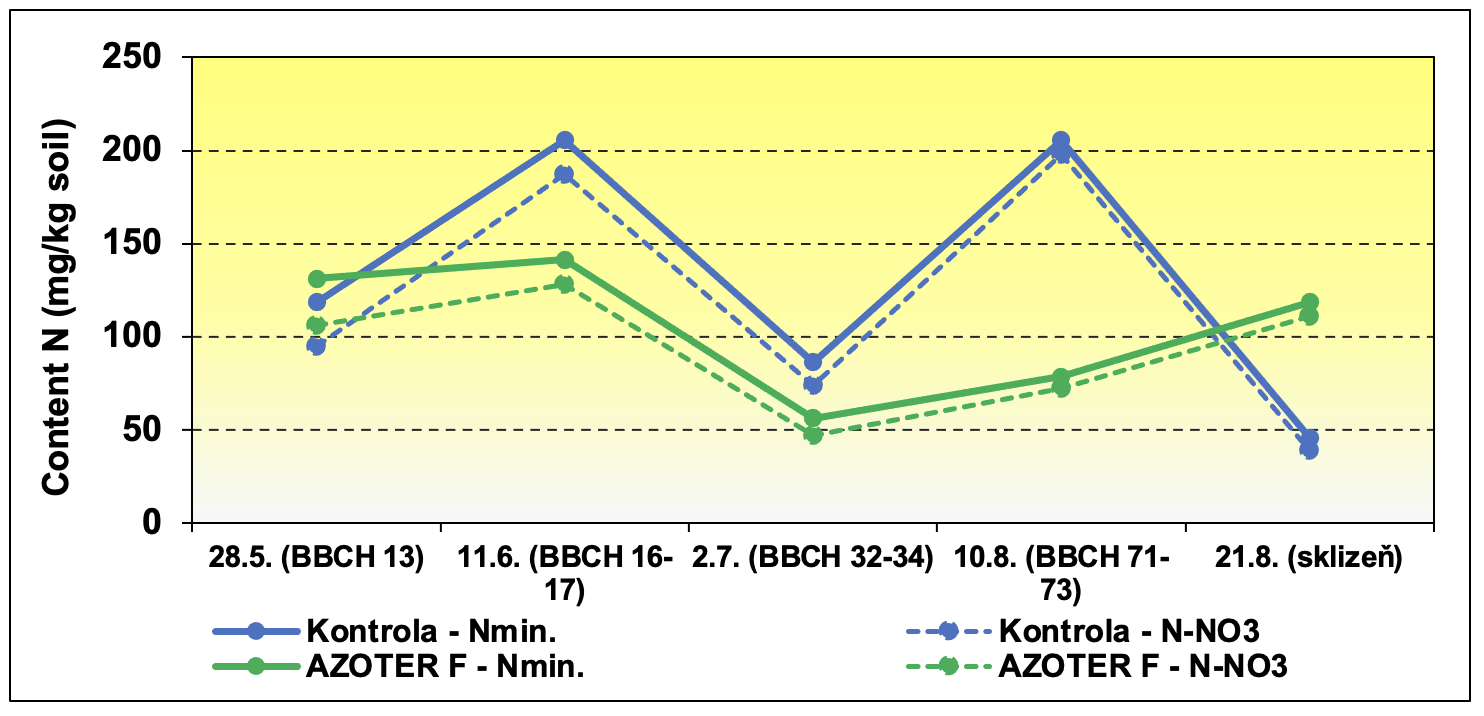
However and compared to Nmin, the application of AZOTER F fertilizer had a positive effect of available phosphorus (PH2O) in the soil. Although, in the untreated control, almost 50% of higher dose of phosphorus was applied to the soil in the mineral fertilizer (NPK), the content of available PH20 in the soil was significantly lower than after the half dose, supplemented with the application of AZOTER F biological fertilizer (Graph 5). Apparently, the application of AZOTER F fertilizer maintained the level of PH2O after 20 days from the application performed on 28.5 at a higher required level than the usual application of mineral fertilizers. After the application of AZOTER F fertilizer, the content of PH2O at 6-7 leaf stage (BBCH 16-17) was 11.0 mg / kg (good). After the application of a full dose of phosphorus in NPK the value was only 4.7 mg / kg (very small). Phosphorus from mineral fertilizers is released by adequate amount of rainfall and the availability of phosphorus for plants is considerably limited by the soil reaction (pH), which was a bit acidic on the plot. After the application of AZOTER F, the supply of phosphorus to the soil solution was obviously more gradual and was not subject to any transformation into clayish or ferruginous sediment as it is known with mineral fertilizers. During the period of reduced maize absorption capacity for phosphorus (starting 5 leaf stage = BBCH 15) the supply of PH20 was good after the application of AZOTER F. Subsequently during the vegetation, the content gradually decreased and during the period of early maturity of grain, it was fully comparable with mineral fertilizer NPK in fertilized control. During the harvest period, the residue of PH2O content for the application of AZOTER F fertilizer to the soil was at the level of 2.1 mg / kg and after application of the full dose of phosphorus in NPK fertilizer, it was at the level of 3.2 mg / kg. Residual PH2O supply after the harvest remained extremely very small.
Graph 5. Comparison of the dynamics in the content of acceptable water- soluble phosphorus (Ph2o) in the soil, under the maize stand on the treated (AZOTER F) and untreated plot before sowing. on 8. 5.
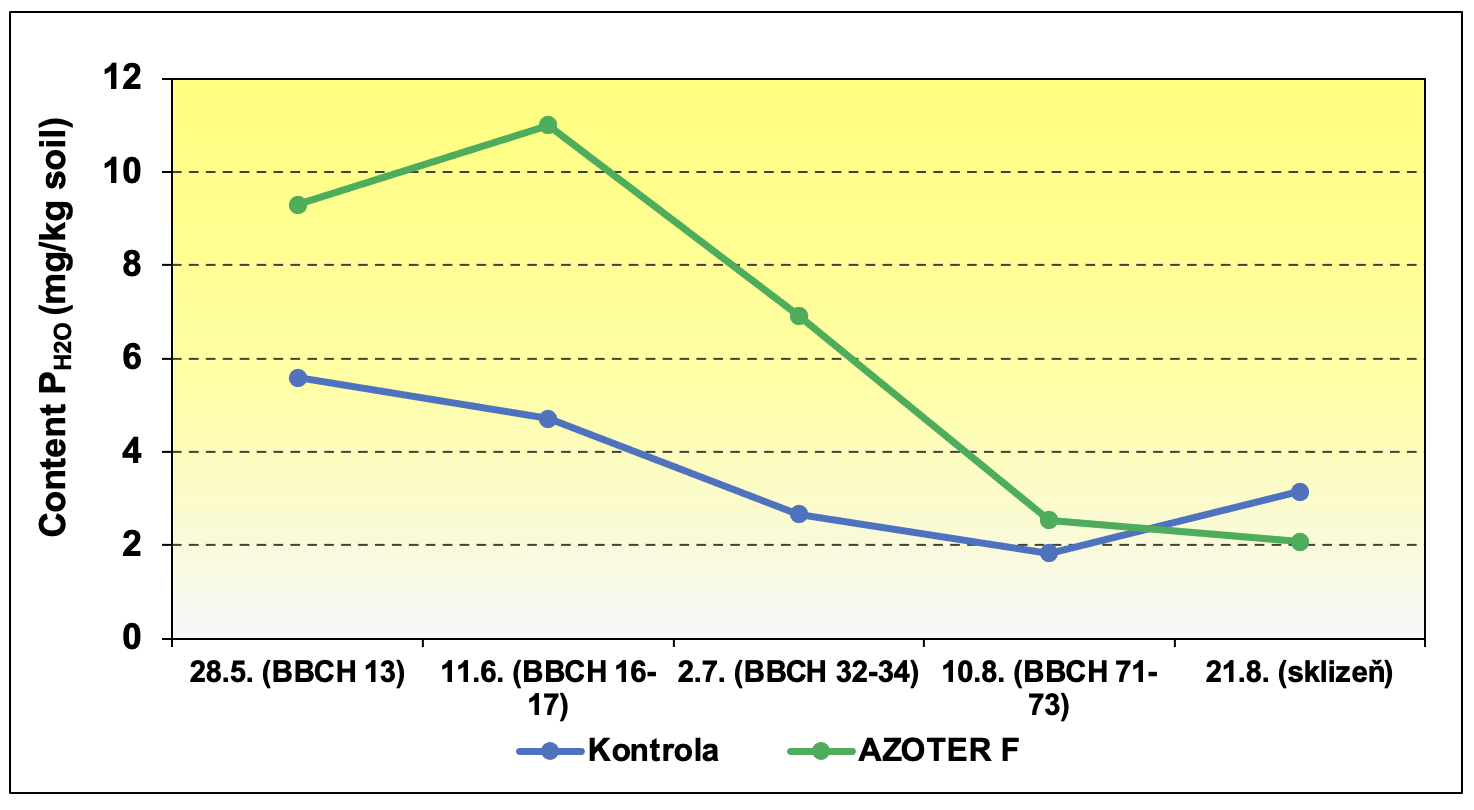
The application of AZOTER F biological fertilizer positively changed the soil reaction (pH). After the maize harvest, on 21 August the soil pH value was at the level of 6.7, which was by1.0 more than on the 20th day after application (28 May), or which was by 1.1 more before the experiment (pH = 5.6) (Graph 6). After using the full diagnosed dose of nitrogen, phosphorus and potassium on the untreated control plot (AZOTER F), there was an undesirable decrease in soil pH value from 6.5 at the beginning of the experiment (May 28) to 5.8 on the harvest day (August 21), ie the pH value by 0.7 lower. The lower level of nitrogen application and the lower content of Nmin in the soil during the vegetation after the application of AZOTER F obviously reduced the effect of acidification of the soil with nitrogen fertilizers. There was no excessive formation of acidic components during the decomposition and transformation of nitrogen in the soil.
Graph 6. Comparison of the soil reaction (pH) at the beginning of the experiment and at the time of harvest on the treated (AZOTER F) and untreated plot (soil was treated before sowing on 8.5).
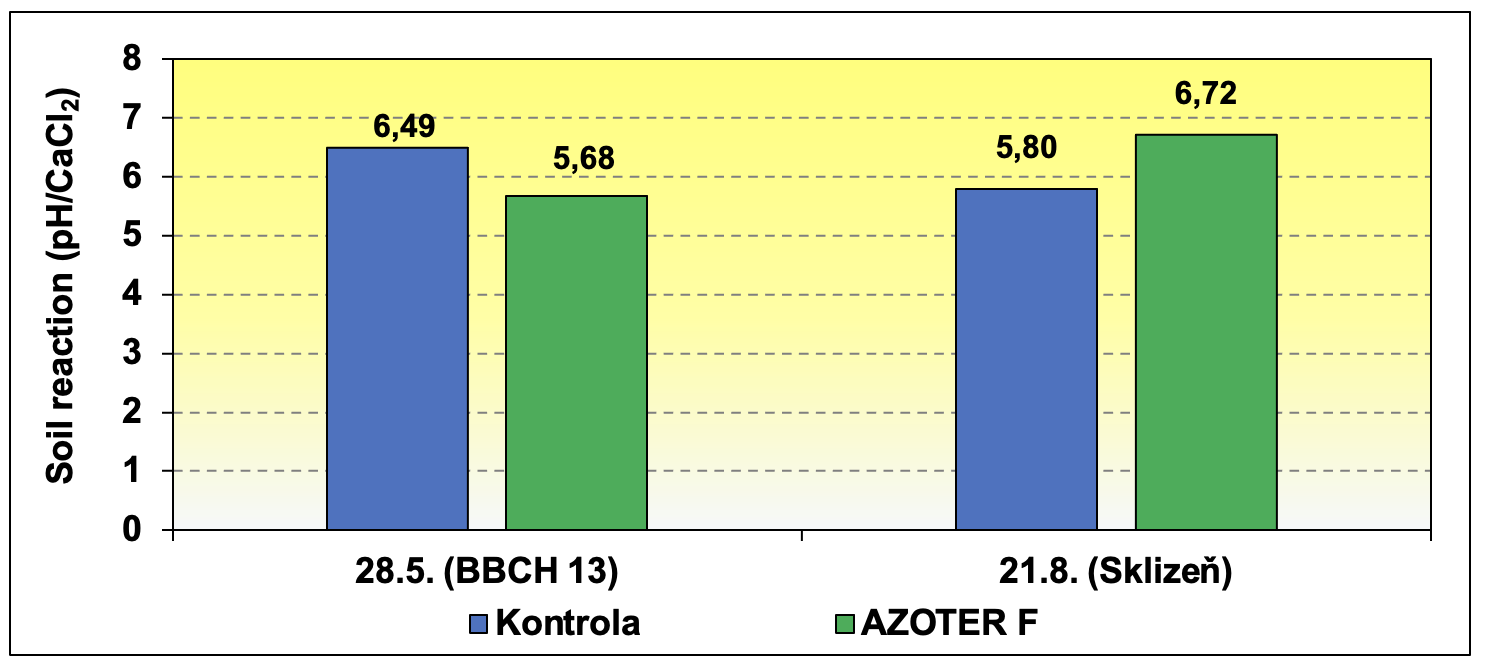
After harvest, the soil showed a decrease in available nutrients except calcium, after AZOTER F application. Here the value of calcium was from 2930 mg / kg of soil to 4380 mg / kg, ie a very high supply, which appeared positively on the pH value of soil (Graph 7).On the contrary, on the fully fertilized plots with NPK mineral fertilizer, the content of available calcium was reduced to 2220 mg / kg, most probably by moving from the sorption complex away caused by an increased level of nitrogen (N-NH4) prevailing during the vegetation. This was reflected in a decrease in the value of soil pH (see above). The release of calcium from the soil was synergistically influenced by the action of applied bacteria in the fertilizer AZOTER F, which binds atmospheric nitrogen. The content of available phosphorus showed a comparable decrease after harvest compared to the state at the beginning of the experiment, both on treated and untreated variants with AZOTER F fertilizer. The potassium content also showed a comparable decrease after harvest on both plots. After harvest and after conventional NPK ferilization, the available magnesium content decreased less than after treating the soil with AZOTER F fertilizer. This was due to the higher uptake of magnesium by more abundant aboveground maize biomass on plot treated with AZOTER F fertilizer.
Graph 7. Comparison of the available nutrients (in Mehlich III extract) in the soil at the beginning of the experiment and at the harvest period on treated and untreated AZOTER F plot (treated on 8.5).
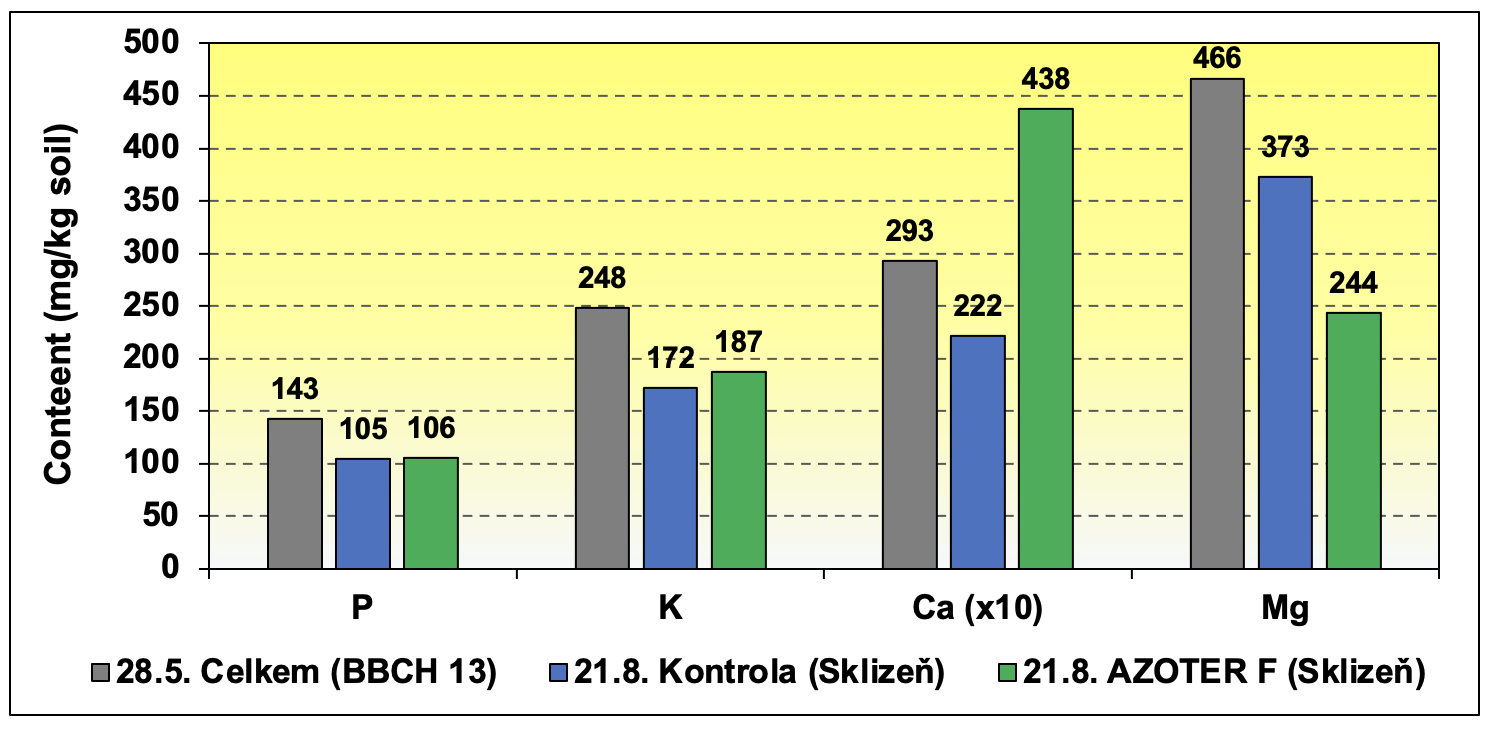
The vegetation status of plants during the vegetation period was monitored by taking representative samples of average plants and on each plot in the period from 28 May to 21 August (Graph 8). In the period of early 3rd leaf stage(BBCH 13), the plants showed the same dry weight of aboveground biomass on untreated and treated plots with AZOTER F fertilizer. Later at 6th – 7th leaf stage (BBCH 16 – 17) and after application of AZOTER F fertilizer to the soil the dry matter weight of aboveground biomass was 0.43 t / ha. At that time, on untreated AZOTER F control plot with full dose of NPK mineral fertilizers, the dry weight of 0,39t/ha was by 9% lower. In the intensive growth of the maize stalk (values for column = BBCH 32 – 34) the dry matter weight of aboveground biomass was 2.85 t / ha on untreated plot. Soil treated with AZOTER F fertilizer has already provided a significant 33% higher increase in dry matter weight of aboveground maize biomass. The plants accelerated the growth and launching of the individual phenological phases after the application of AZOTER F to the soil. This was reflected in a 43% higher increase in dry matter weight of aboveground biomass (17.1 t / ha) in the period of early and milk-waxy grain maturity (BBCH 71 – 73) compared to the untreated control plot (9.8 t / ha) with full NPK fertilization. At harvest period, the plants showed a 37%higher increase in dry matter weight of aboveground biomass (17.9 t / ha) than conventional plants (11.2 t / ha) at the full diagnosed dose of NPK in mineral fertilizers.
Graph 8. Dynamics of increase in dry matter weight of aboveground maize biomass during vegetation on treated and untreated AZOTER F plots (treated soil before sowing on 8 May)
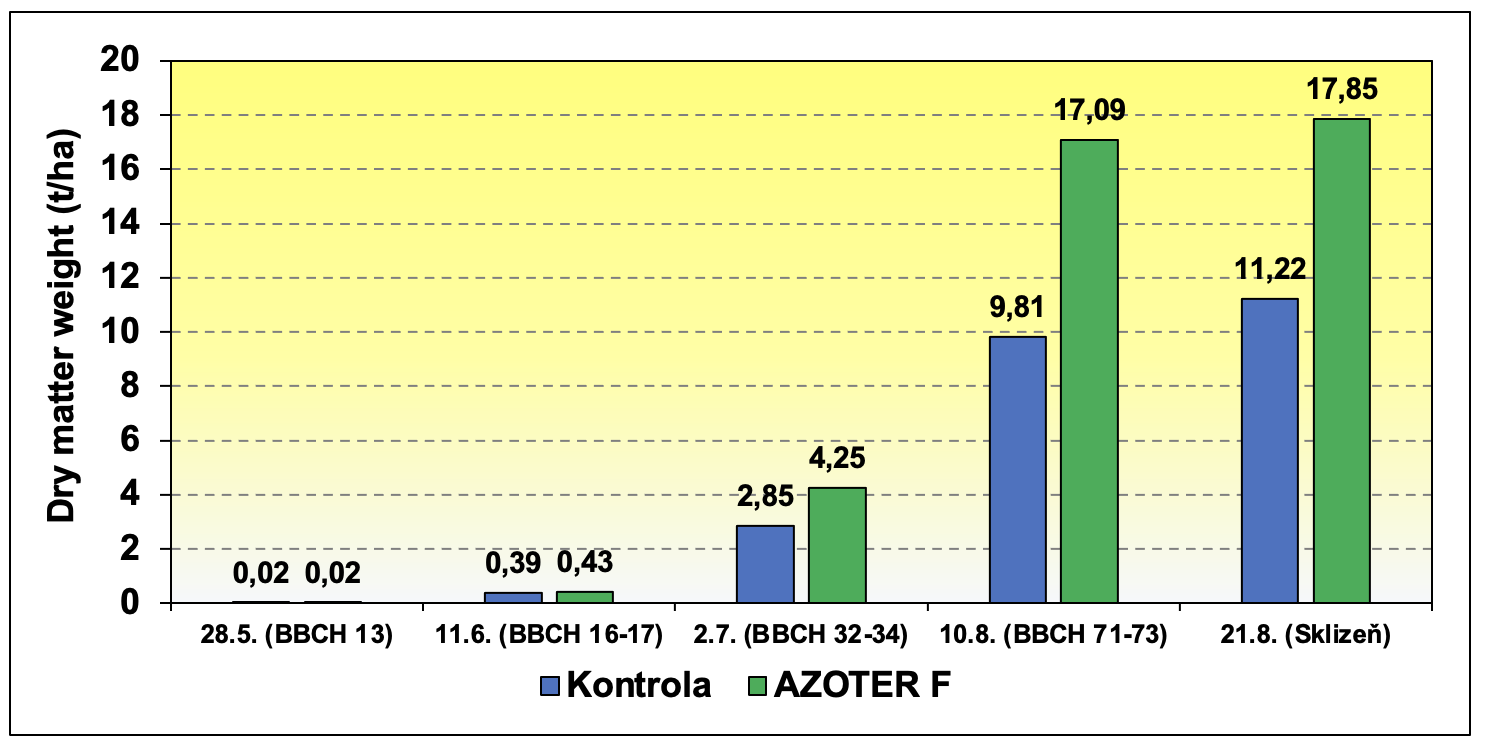
During vegetation, the nutritional status of plants with nitrogen was better at the 3rd leaf stage on untreated AZOTER F fertilizer plot (N content = 4.77% in dry matter) (Graph 9) Nitrogen nutrition was slightly lower on the treated plots (N content = 4.45% in dry matter). Then, at the 6th leaf stage, nitrogen nutrition was still lower (N content = 2.77%) on the treated AZOTER F plots in comparison with the fully fertilized control (N content 3.44%). At the 6th – 7th leaf stage, the nutritional status with nitrogen was better (content N = 2.67%) on the treated plot with AZOTER F fertilizer in comparison with the untreated control (content N = 2.65%). Especially at this time, there was a significant increase in the dry matter weight of the treated variant while maintaining the nitrogen content in the dry matter (nitrogen uptake was sufficient and the dilution effect was suppressed). In the period after intensive growth of aboveground biomass in waxy grain maturity, the nutritional status of plants with nitrogen was better (content N = 2.67%) after application of AZOTER F fertilizer into the soil in comparison to the untreated control (content N = 2.65%). The nitrogen content in the dry matter, after the application of AZOTER F fertilizer was maintained even after a twofold increase in the dry weight of the plants. At harvest, nitrogen nutrition on the variant treated with AZOTER F fertilizer showed a decrease (N content = 1.16% in dry matter). On the contrary, there was a slight increase on the untreated control (N content: 1.48% dry matter).The dry matter weight of the treated variant was twice as high as that of the untreated control. In comparison with the middle part and the end part of vegetation, with deep nitrogen deficiency in control plants and where the soil was not treated with AZOTER F fertilizer before sowing, the nutritional status of plants with nitrogen reached the optimal state at the 6th – 7th leaf stage.
Graph 9. Dynamics of nutritional status of maize plants during the vegetation period on the treated and untreated AZOTER F plot (treated soil before sowing on 8.5, optimum AGROEKO)
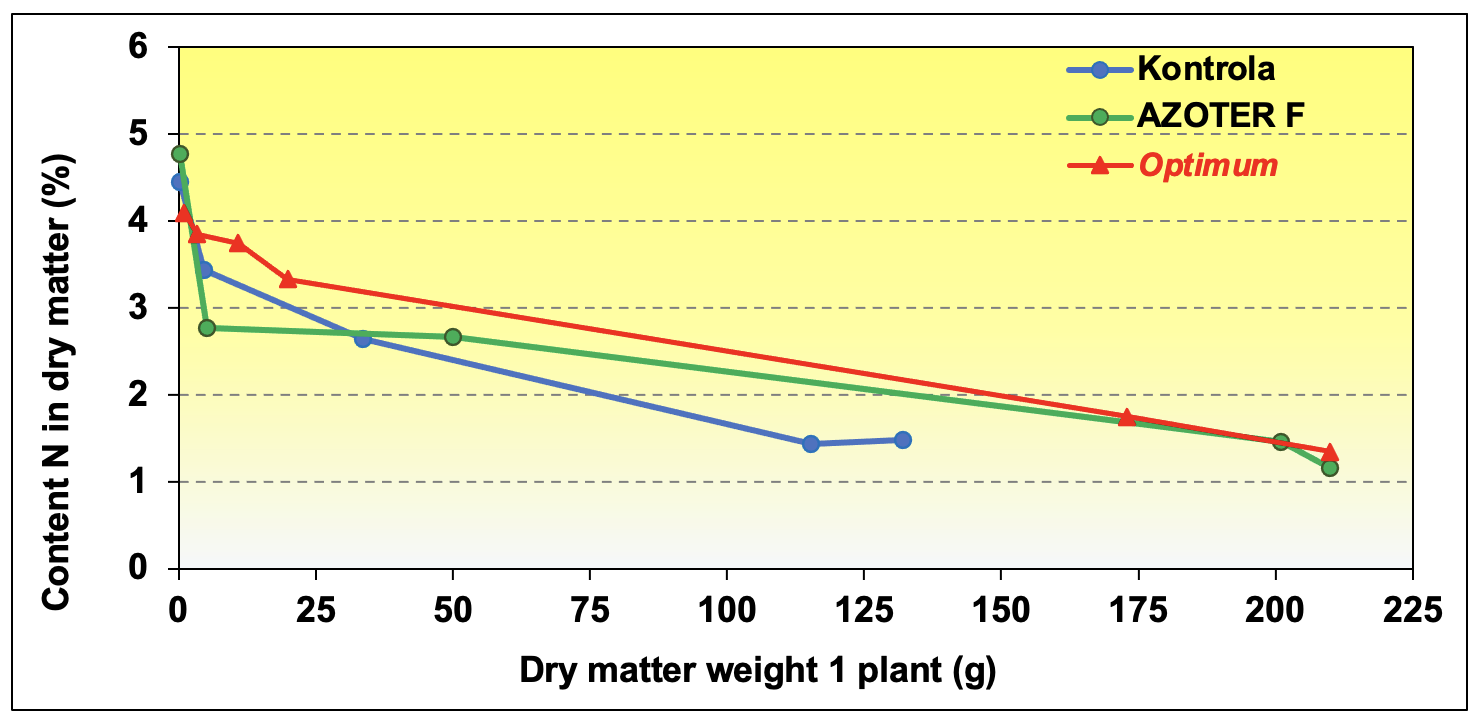
The nutrition of maize plants remained evaluated by using another diagnostic method based on the evaluation of the fulfillment of optimal element contents in plant dry matter in the developed phenophase, ie regardless of the actual increase in plant dry weight (Table 6).After application of AZOTER F fertilizer, the nitrogen content at the beginning of vegetation period at the 3rd leaf stage was higher than the optimum content that was typical for this period, but later with a faster increase in dry weight in the growth phase, nitrogen nutrition was not optimal. The same trend was observed in the untreated control. At the same time, a similar trend was for phosphorus, potassium, calcium and magnesium. The element content in the dry matter was usually lower on the treated variants with the fertilizer AZOTER F for stimulation almost 2x higher weight increase of plants and the associated decrease in the content of the element. As a result, the nutritional status of the plants was better than that of the less grown stand with a higher (undiluted) element content.
Table 6. Comparison of the effect of the application of AZOTER F fertilizer on the nutritional status of maize plants during vegetation period in 2018 with an extreme rainfall deficit (50 % of normal)
| Date | Treatment | Dry matter (g) | N (%) | Optimum (%) | P (%) | Optimum (%) | K (%) | Optimum (%) | Ca (%) | Optimum (%) | Mg (%) | Optimum (%) |
| 28.5.18 | Control | 0,20 | 4,45 | 109 | 0,50 | 125 | 3,57 | 102 | 0,63 | 97 | 0,32 | 84 |
| BBCH 13 | AZOTER F | 0,19 | 4,77 | 116 | 0,60 | 150 | 3,53 | 101 | 0,60 | 92 | 0,36 | 95 |
| 11.6.18 | Control | 4,64 | 3,44 | 89 | 0,31 | 82 | 3,00 | 81 | 0,54 | 87 | 0,40 | 105 |
| BBCH 16-17 | AZOTER F | 5,06 | 2,77 | 72 | 0,24 | 63 | 2,61 | 71 | 0,43 | 69 | 0,30 | 79 |
| 2.7.18 | Control | 33,57 | 2,65 | 71 | 0,26 | 68 | 3,05 | 78 | 0,51 | 85 | 0,35 | 100 |
| BBCH 32-34 | AZOTER F | 50,00 | 2,67 | 72 | 0,27 | 71 | 3,70 | 95 | 0,56 | 93 | 0,32 | 91 |
| 10.8.18 | Control | 115,4 | 1,44 | 82 | 0,22 | 96 | 1,65 | 114 | 0,34 | 97 | 0,18 | 75 |
| BBCH 71-73 | AZOTER F | 201,1 | 1,46 | 83 | 0,23 | 100 | 1,52 | 105 | 0,30 | 86 | 0,18 | 75 |
The maize stand on the untreated control reached a dry forage yield of 7.52 t / ha (Graph 10). Application of AZOTER F fertilizer to the soil increased forage yield by 28% to 9.63 t / ha. The quality of forage was also significantly affected. The yield of the energy component of starch was only 0.38 t / ha on the control untreated plot. The application of AZOTER F fertilizer significantly increased starch yield by 7.1 times to 2.68 t / ha. The yield of nitrogenous substances was comparable to 0.70 t / ha on untreated and treated plots. The application of AZOTER F fertilizer before sowing increased the crude fiber yield by 10%, ie to 2.08 t / ha. The fiber yield on the control plots was 1.89 t / ha.
Graf 10. Comparison of the maize forage yield and quality components after application of AZOTER F fertilizer before sowing (before pre-sowing preparation on 8.5., harvest on 21.8.)
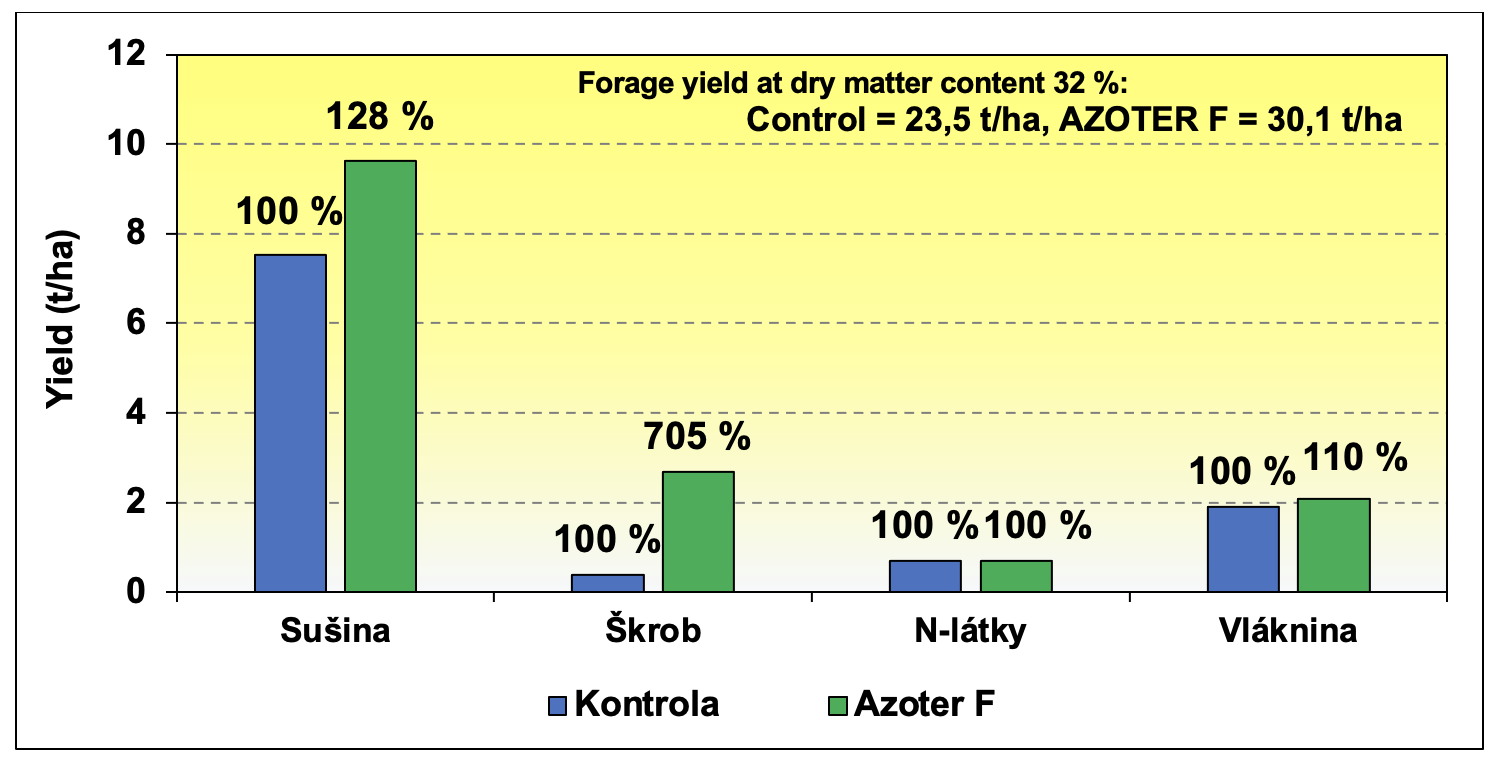
Harvest samples of 10 representative plants of maize from the control and AZOTER F treated plot before sowing showed a 33% increase in the weight of fresh plants (Table 7). The plants on the untreated plot had a 31.6% proportion of the total weight formed by the cobs. On the plot with AZOTER F fertilizer before sowing, the proportion of weight of cobs in the forage increased to 34.9%. The application of AZOTER F fertilizer increased the average number of grains in rows on the cob by 2% from 15.3 to 15.6 pieces. Application significantly increased the number of grains in a row (cob length) by 30% before sowing with AZOTER F fertilizer in comparison with the untreated control. Application of AZOTER F fertilizer to the soil before sowing increased the weight of a thousand grains (size) by 15% compared to the untreated control.
Tab. 7. Comparison of the yield-forming elements of the maize stand without and with the AZOTER F fertilizer before sowing (application before pre-sowing preparation on 8.5.)
| Treatment | Laboratory yield of 10 plants (g) |
Weight of cobs ratio (%) | Number of rows (pcs./cob) | Number of grains (pcs./row cob) | HTZ (g)
Weight of thousands of grains |
|
| Control (K) | 490a±83 | 31,6a±9,3 | 15,3a±1,4 | 21,0a±4,8 | 298 | |
| Azoter F (A) | 736b±92 | 34,9a±6,6 | 15,6a±1,9 | 29,8b±2,3 | 350 | |
| Difference (K-A) | +33 % | +3,3 % | +2 % | +30 % | +15 % |
Note: Values marked in the column with different letters (a, b) report statistically significant difference at the level of significance p <0.05 (ANOVA, Fisher’s LSD test).
The quality of forage on control untreated plots was significantly different from the one treated with AZOTER F fertilizer. The application supported a faster growth of aboveground biomass, which was reflected by almost 10,1% of higher dry matter content in the forage during the harvest, compared to control (Table 8). It the control, the dry matter content of the forage was only 26.5%, which indicated insufficient dry matter content for successful preservation. After the application of AZOTER F, the dry matter content was 36.6%, which was a slightly higher optimal value (optimum 32 – 35%) for silage.
The difference of the starch content in the forage was highly significant. On an untreated control, smaller plants with lower assimilation capacity and deposition capacity transformed in extreme dry weather only 5.1% of the starchcontent in the dry matter. The low deposition of starch in the forage on the control plot is evidenced by the high content of 19.4% of simple (non-metabolized) slightly soluble sugars in the forage. The application of AZOTER F fertilizer before sowing enabled the transformation of simple sugars (LR sugar) into polymeric starch structures with a satisfactory content of 27.8% in dry forage. The content of slightly soluble sugars in the forage was an acceptable 7.4%. The content of N-substances in forage was 2% higher on control plot, where the content (9.3%) approached the limit of 10% for successful preservation. After application of AZOTER F, the usual satisfactory content of N-substances was determined to be 7.3%.
In addition, the analysis of 3 main toxic products of fungi and molds in maize forage was performed. The contents of mycotoxin DON and Aflatoxin BI were very low (trace elements) below the limit of laboratory detection on treated and untreated plots. The mycotoxin of maize Zearalenone was determined in the laboratory at the limit of detection. The content of Zearalenone on untreated plot was 6 pg / kg and after AZOTER F application to the soil a content was slightly higher than 10 pg / kg. For extremely rainfall-deficient maize vegetation, including the period of harvest, the infectious pressure of fungi and molds in maize stands was very low. The described side effect of the bacteria contained in AZOTER F for suppression of the mycotoxin agent in forage was therefore negligible.
Table 8. Comparison of the quality of maize forage on the day of harvest on the control plot without and with AZOTER F fertilizer before sowing (application on 8. 5. and havest on 21.8.)
| Plot | Dry matter (%) | Starch (%) | LR sugars (%) | N-substances (%) | fibre (%) | DON (mg/kg) | Zearalenon μg/kg | Aflatoxin-B1 μg/kg | |
| Control (K) | 26,54 | 5,07 | 19,40 | 9,27 | 25,2 | 0 (<0,1) | 6 | 0 (<2) | |
| Azoter F (A) | 36,61 | 27,80 | 7,40 | 7,26 | 21,6 | 0 (<0,1) | 10 | 0 (<2) | |
| Differenece (K-A) | +10,07 | +22,73 | -12 | -2,01 | -3,6 | 0 | +4 | 0 |
The result of AZOTER F bacterial fertilizer in the soil before maize sowing positively reflected the economic profits of growing maize for silage. (Table 9). Although the year 2018 was extremely dry with a lack of rainfall (below 50% of the total rainfall in the period from April to September), AZOTER F application provided sufficient forage yield to make a positive contribution to the subsequent fixed costs of crop production. The application of AZOTER F bacterial fertilizer fully replaced the application of 150 kg of pure NPK nutrients per 1 ha in mineral fertilizers, which led to cost savings on their purchase (in the experiment, classic urea and blended granular fertilizer Agromix NPK were selected) at a price of CZK 2.532 / ha.
After adding the cost for AZOTER F bacterial fertilizer at a price of CZK 1.250 / ha (application is 10 1 per ha + application price), the variant of growing maize with only 50% dose of NPK in mineral fertilizers in combination with AZOTER F fertilizer showed a total cost saving of CZK 1.282 / ha.
To increase the forage yield by 28% after the application of AZOTER F fertilizer compared to the conventional technology of the full dose of NPK fertilizers, AZOTER technology reported a contribution in the amount of CZK 1.947 / ha. The higher costs of fertilization with a full dose of NPK nutrients in mineral fertilizers and achieved much lower forage yield were reflected in the conventional technology (on experiment control) of maize cultivation with a negative contribution of CZK 3.355 / ha.
Conventional technology of fertilizing the maize with NPK mineral fertilizers did not provide financial resources to cover fixed costs and the production process can be evaluated as significantly loss-making when there is absence of the rainfall in the locality. If the course of vegetation was normal in terms of the amount of atmospheric precipitation during the intensive growth of maize, it is possible to achieve a yield of fresh forage of about 40 t / ha without using AZOTER F bacterial fertilizer in the experimental locality of Ohnišov. With its use under good humidity conditions, it is possible to expect unchanged state of the identified benefit of this fertilization technology for maize. The application of AZOTER F to the soil supports the efficiency of all inputs in the production process.
Tab. 9. Comparison of contribution in fertilization technology with full dose of NPK fertilizers in mineral fertilizers (control without AZOTER F application) and with innovative technology of half dose of NPK fertilizers in combination with AZOTER F bacterial fertilizer before maize sowing (based on the result of the experiment in 2018 in the locality of Ohnišov).
| Indicator | Control (100 % dose of NPK fertilizer) | AZOTER F (50 % dose of NPK fertilizer) |
| Market output (TV) | ||
| Forage for silage
32 % dry matter content |
23,4 t/ha in fresh matter
= CZK 14.040/ha |
30,1 t/ha (+28 %) in fresch matter =
CZK 18.060/ha |
| Variable costs (VN) | ||
| Fertilizers including application | Urea 46 % N, 350 kg/ha = CZK 2.580/ha | Urea 46 % N, 175 kg/ha = CZK 1.390/ha |
| NPK 3-13-45, 300 kg/ha = CZK 2.885/ha | NPK 3-13-45, 150 kg/ha = CZK 1.543/ha | |
| KieseritESTA, 100 kg/ha = CZK 930/ha | KieseritESTA, 100 kg/ha = CZK 930/ha | |
| — | AZOTER F, 10 l/ha = CZK 1.250/ha | |
| Fertilizers total = CZK 6.395/ha | Fertilizers total = CZK5.113/ha | |
| Other common | Tillage of soil including manure,seed, sowing, herbicíde, insecticíde, harvest = CZK 11.000/ha | Tillage of soil including manure,seed, sowing, herbicíde, insecticíde, harvest = CZK11.000/ha |
| Total | Total of above = CZK 17.395/ha | Total of above = CZK 16.113/ha |
| Savings VN | — | Fertilizers total = CZK 1.282/ha |
| Contribution (PÚ = TV – VN) | ||
| Total | = CZK –3.355/ha | = CZK 1.947/ha |
Note: Calculation of internal accounting price for maize forage for CZK 600/11, price calculation of granular fertilizer application with the spreader for CZK 200/ha including import of fertilizers, application of AZOTER F liquid bacterial fertilizer with sprayer on the soil before sowing, including import of water for CZK 300/ha.
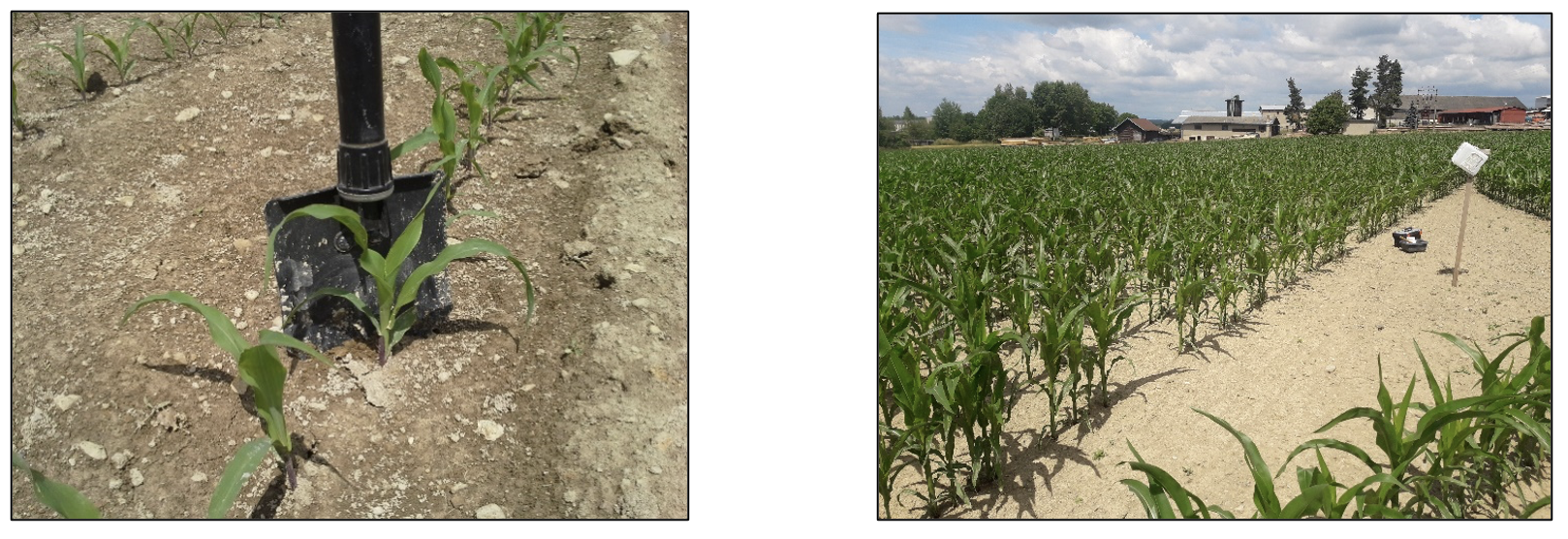
Maize stand on semi-operational experiment in the locality of Ohnišov on 25. 6. (AZOTER F applicatio carried out before sowing on 8. 5. with subsequent ploughing by pre-sowing preparation)
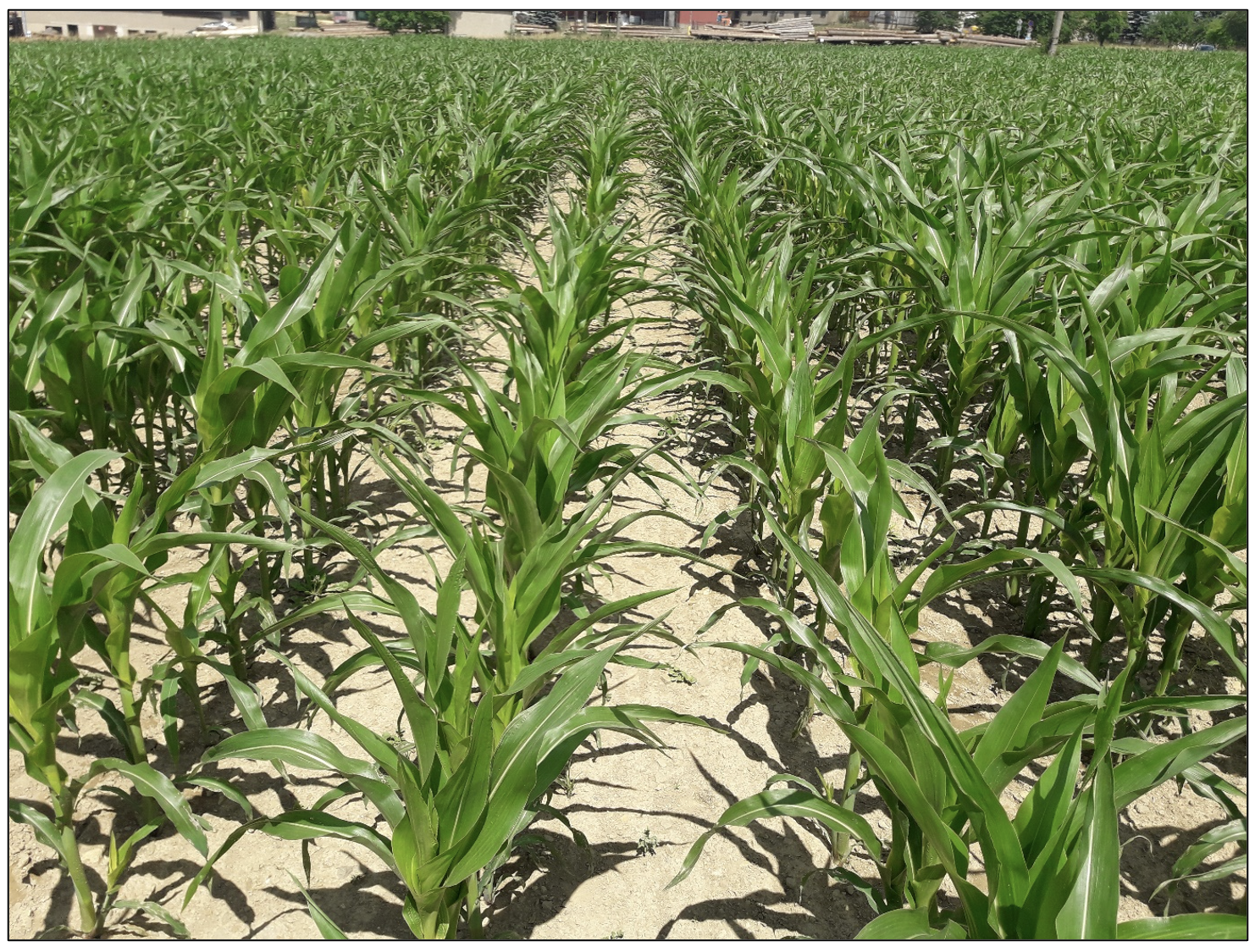
Average placing and graining of maize cobs Plants for forage quality analysis here on 21.8.
after AZOTER F application (situation on 10.8) after AZOTER F application to the soil
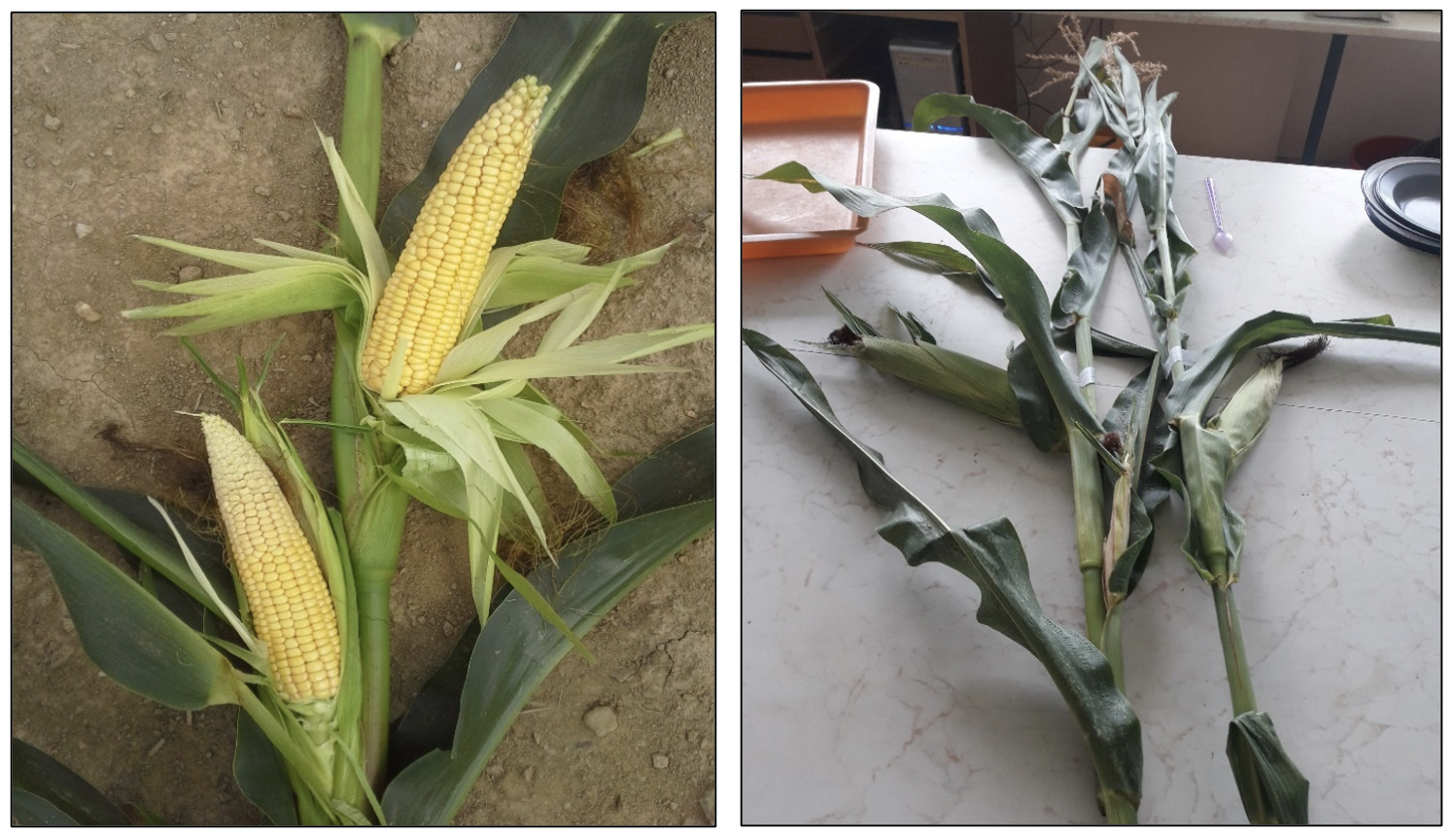
Conclusion from the verification of AZOTER technologies in 2018
The previous control measurement and semi-operational experiment in oilseed rape and spring crops of maize and sugar beet that are demanding for their nutrition and fertilization, show a positive effect of the tested biological preparations:
The application of the AZOTER L bacterial preparation in foliar application on maize and sugar beet stand significantly supported the intake of nutrients and effectively stimulated the plants growth of aboveground biomass. Significant difference in the intensity of growth and in the intake of nitrogen and other nutrients was found on the 12th -14th day after application. After application, the plants overcame the stress from long-term lack of rainfall better. AZOTER L application at the 5th leaf stage predicted an increase in forage yield by up to 44% in the locality of Slatina nad Zdobnicí. At the same time, AZOTER L application increased the content of starch in the forage by 5.1%.
The application of AZOTER F bacterial preparation to the soil in Ohnišová, before the subsequent pre-sowing preparation, resulted in a sufficient supply of nitrogen (Nmin.) to the soil and a higher supply of phosphorus (PH2O)to the soil. Application of AZOTER F bacterial preparation to the soil increased the soil reaction by synergistic action of nitrogen-binding bacteria to release calcium from the worse available forms in the soil. Maize plants showed an almost twofold increase in the weight of aboveground biomass since the 6th leaf stage and received a sufficient nitrogen amount and other macronutrients. Maize plants provided 28% higher forage yield and more than 7 times higher starch yield compared to conventional NPK fertilized control in mineral fertilizers without AZOTER F application. In the production process, costs for NPK fertilization were saved in the amount of CZK 1.282/ha and a positive contribution was calculated in amount of CZK 1.947 / ha.
In Žamberk on 12. 11. 2018
Elaborated from the results of control measurements and experiments performed on the pilot companies for the contracting authority AZOTER CZ s.r.o.
AZOTER preparation/agent is approved for use in organic farming and it is registered with the international company BIOKONTROLL. Reg. No: 02.5 /710/7/2009.
Council Regulation (EC) No: 834/2007 and CR No: 889/2008 (EC) Annex I.


